
If you want to prosper, consider building roads China’s role in African infrastructure and capital projects
12 minute read
22 March 2019
China’s Belt and Road and Silk Road initiatives are creating fresh waves of road, rail, port, and energy investment in Africa, making the continent more connected internally and with the outside world.
The Achilles’ heel for Africa’s economic development
If you want to prosper, first build roads, says a Chinese proverb.1 This certainly appears to hold true in Africa. The continent should build many roads, railways, ports, and power plants, as large infrastructure gaps remain an obstacle to growth, investment and economic diversification.
Recent estimates by the African Development Bank (AfDB) put the continent’s minimum infrastructure needs – for countries to sustain the growth of their economies, population, income level and replace ageing infrastructure – at US$130bn to US$170bn per annum. At least half of that requirement is currently unfunded.2
Investment in infrastructure and capital projects (I&CP) can be essential to diversify economies and promote private sector activity and industrialisation, ensuring enough jobs are created for the 12 million young people entering Africa’s labour force each year.3
Infrastructure investment also increases business confidence and draws in investments in other sectors, fosters innovation and productivity and lowers transaction costs, facilitating trade in goods and services and the transfer of talent.
The World Bank estimates that Sub-Saharan Africa’s (SSA) gross domestic product (GDP) per capita growth would increase by 1.7 percentage points per annum if the region were to close the infrastructure gap (in terms of both quantity and quality) relative to the developing world median.4 This could also make growth in Africa more inclusive, alleviating poverty across the continent.
Funding infrastructure development
Globally, developing countries investing 30 per cent of GDP or more on gross fixed capital formation (i.e. infrastructure and capital equipment) have been among the fastest growing economies. Between 2010 and 2017, the investment ratio for China and India averaged 44 per cent and 31 per cent respectively, and for the East Asia and Pacific countries grouping (excluding high income countries) it was 40.6 per cent.5
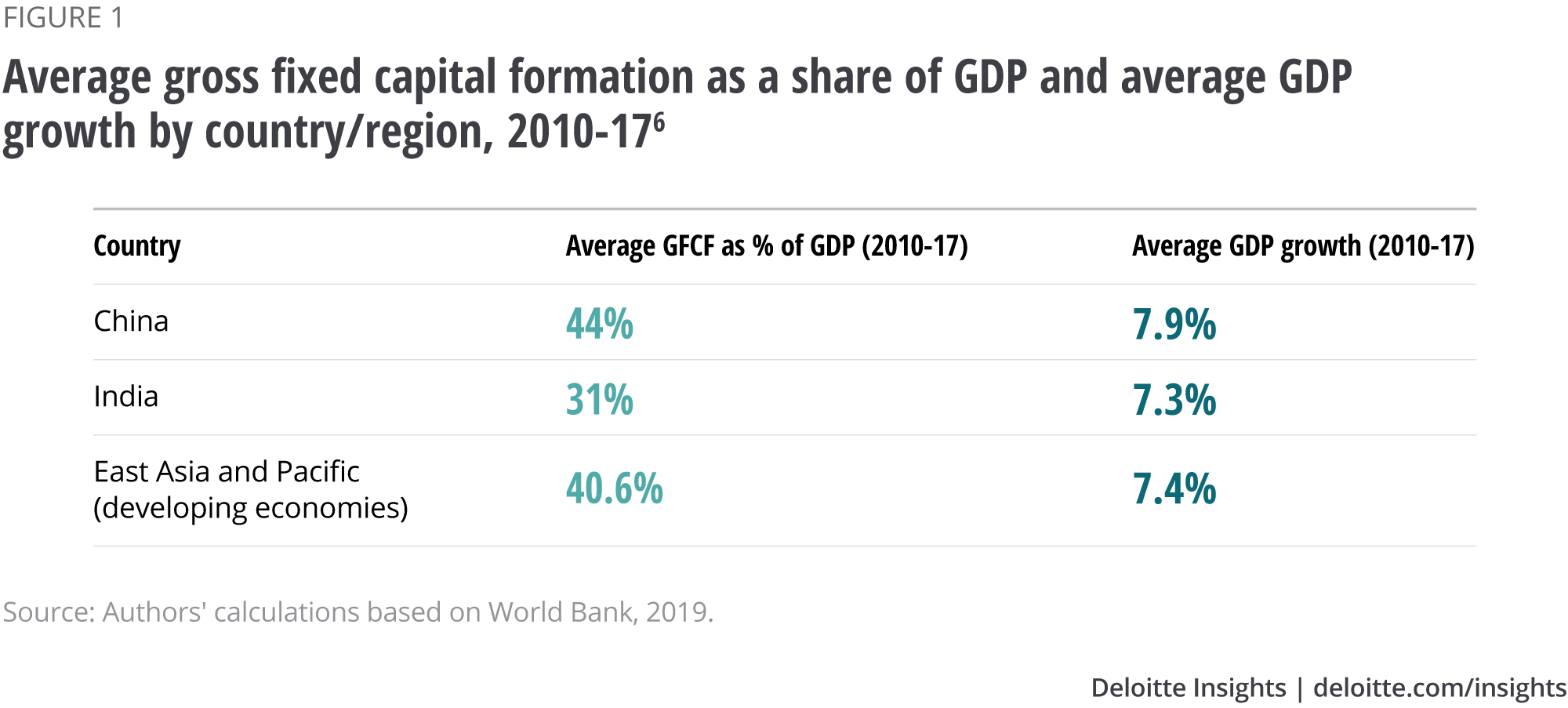
In comparison, African countries continue to underspend. SSA countries have invested on average only 20 per cent of GDP per annum between 2010 and 2017, and North African countries about 22.8 per cent. The two largest economies, Nigeria and South Africa, have also underperformed, with investment ratios of 15 per cent and 19.6 per cent of GDP respectively over the same period. This is comparable to the investment ratio of major developed markets. For example, the United States and Germany invested 19.1 per cent and 19.7 per cent of GDP respectively over the same period. However, both, Algeria and Ethiopia invested more than 30 per cent of GDP since 2010.7
As shown in Figure 2, African infrastructure investment has been funded largely by traditional Official Development Assistance (ODA), Organization for Economic Co-operation and Development (OECD) investors, and non-OECD countries, including China, India, and the Gulf states, with China by far the largest national player.8
Deloitte’s annual Africa Construction Trends report tracks construction projects of US$50m or more that had broken ground by 1 June every year.
Of the 482 projects tracked (worth a total US$471bn), our 2018 report finds that African governments continue to fund the largest share of projects (24.5 per cent), with international development finance institutions (DFIs) and African DFIs financing 13.7 per cent and 9.1 per cent, respectively.
Other sources of financing have been relatively limited. The weak legal and institutional framework and immature local equity markets also challenge investors.
China – the biggest financier of Africa’s infrastructure
However, as seen in Figures 2 and 3, one of the megatrends of our times has been the growing presence of China in Africa’s infrastructure sector. Over the past two decades, China has helped to meet some of Africa’s infrastructure financing needs and is now the single largest financier of African infrastructure,9 financing one in five projects and constructing one in three (see Figure 4).10
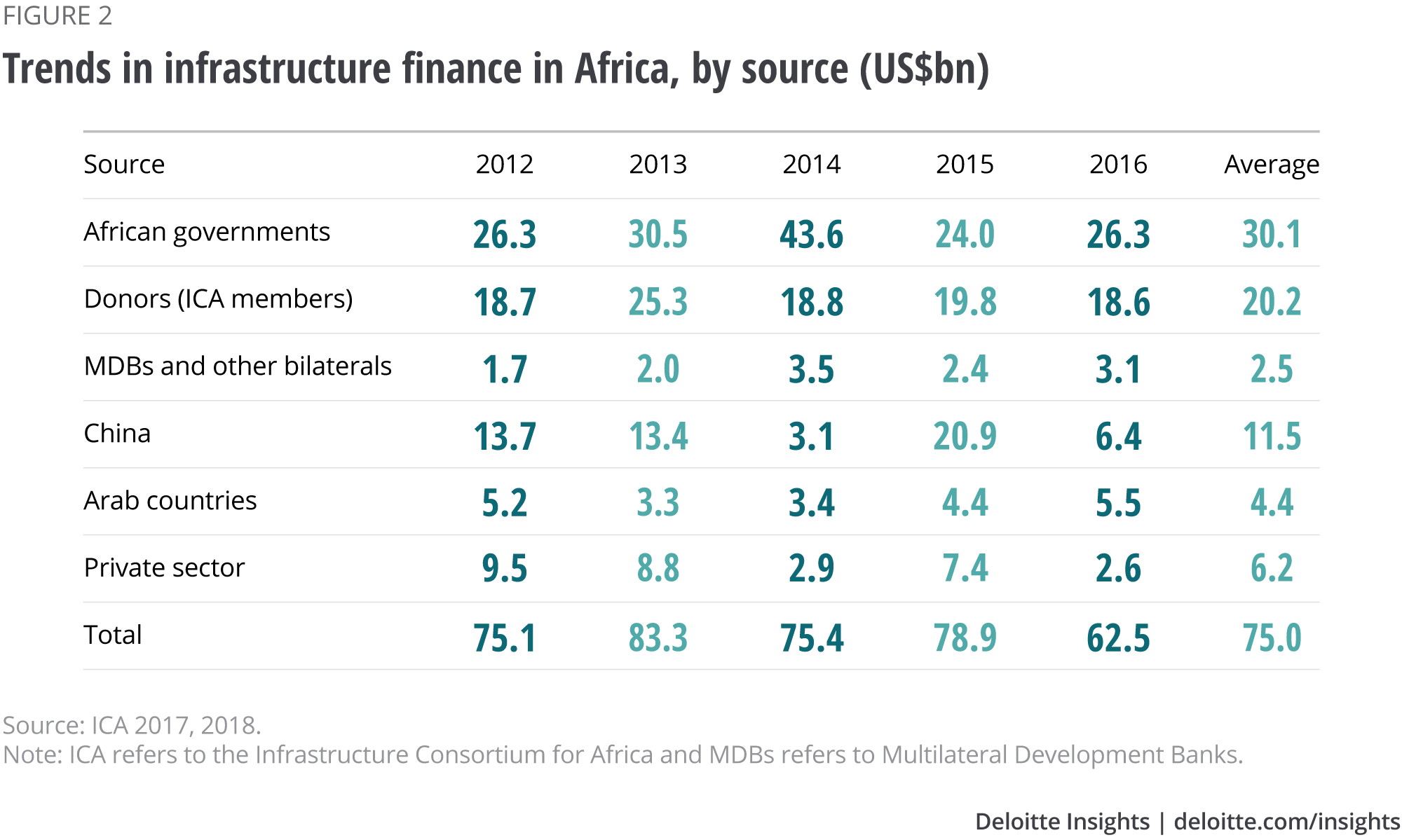
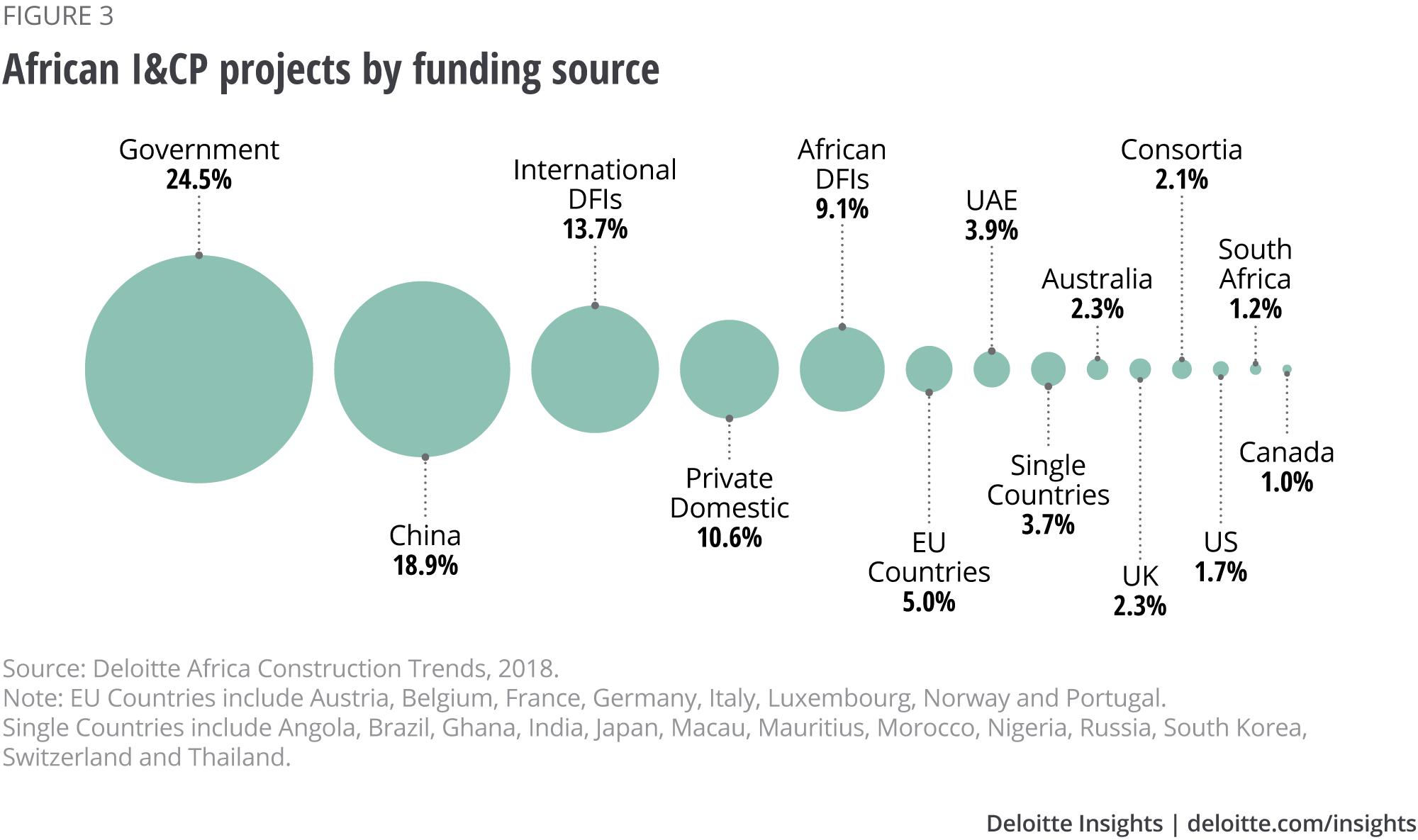
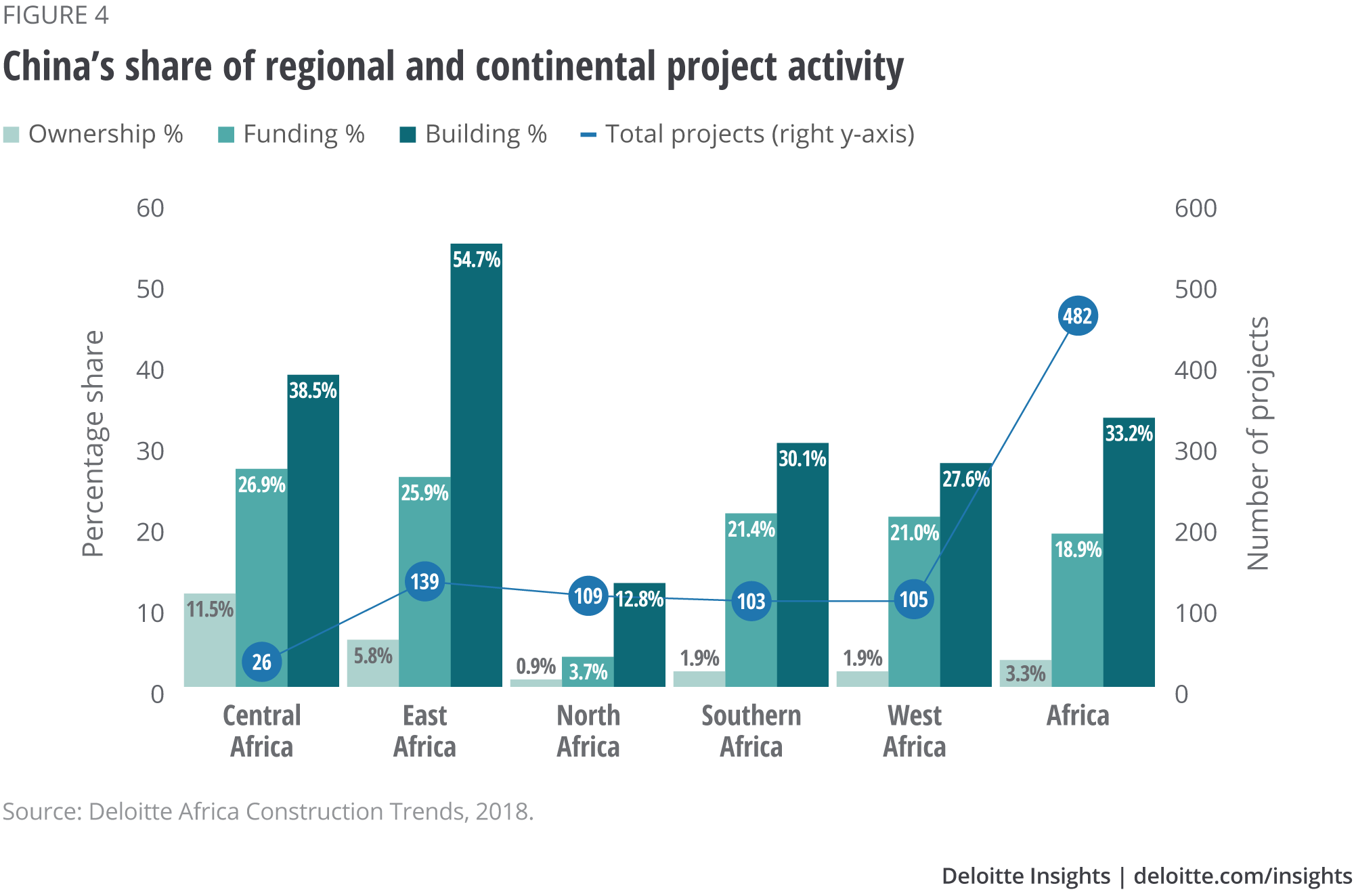
Most funded projects are in the Transport, Shipping and Ports sectors (52.8 per cent), followed by Energy and Power (17.6 per cent), Real Estate (14.3 per cent, including industrial, commercial and residential real estate) and Mining (7.7 per cent) – see Figure 5.
China launched a ‘new’ Africa policy at the turn of the century, culminating in the establishment in October 2000 of the multilateral Forum on China-Africa Co-operation (FOCAC). Since then China has carefully set out and implemented three-year Africa engagement plans.
To date China has participated in over 200 African infrastructure projects. Chinese enterprises have completed and are building projects that are designed to help add to or upgrade about 30,000km of highways, 2,000km of railways, 85 million tonnes per year of port throughput capacity, more than nine million tonnes per day of clean water treatment capacity, about 20,000MW of power generation capacity, and more than 30,000km of transmission and transformation lines.11

Chinese banks behind the financing
Chinese financing for infrastructure projects has come mainly from two policy banks: China Exim Bank provided 67 per cent of the total loans between 2000 and 2015, and China Development Bank 13 per cent.12
As already shown in Figure 2, infrastructure financing provided by China to Africa averaged US$11.5bn between 2012 and 2016, peaking at US$20.9bn in 2015. This included a number of larger transport and energy deals. For example, Chinese lenders provided over 50 per cent of the finance for the US$5.8bn Mambila Hydropower Plant in Nigeria. Another example is the planned Lamu Coal-Fired Power Plant (Kenya), a US$2bn public-private partnership (PPP).13
Part of the attractiveness of Chinese finance is that the loans are offered at subsidised and relatively low interest rates14 and with a maturity of 15 years or more. China Exim Bank is an export credit agency, rather than a development agency. It offers loans on a bilateral basis and evaluates the level of concession taking into account the nature of the projects. The bank’s competitive edge is that it allows countries that do not have enough financial guarantees to use their natural resources as collateral for infrastructure development. This funding model, known as the ‘Angola model’,15 has come in for serious criticism, as the resource-backed loans are seen, among other things, as reinforcing the ‘resource curse’ of recipient economies.
Other sources of Chinese finance have also emerged over the past decade. The China-Africa Development Fund (CADFund) was set up in 2007 with an initial size of US$5bn. By 2018, the CADFund had grown to US$10bn and had invested more than US$4.6bn in over 90 projects in 36 African countries. CADFund projects are expected to boost local exports by US$5.8bn and create local tax revenue of US$1bn.16
Although Africa’s US$100bn plus investment financing gap may not be met solely by Chinese financing, China’s role is seen by many as crucial. China’s commitment was reiterated in September 2018, when President Xi Jinping announced a further US$60bn funding package for Africa and exempted a portion of African debt maturing at the end of 2018. The package consisted of US$15bn of interest-free or concessional loans, US$20bn of credit loans, US$15bn of special loans, and US$10bn in foreign direct investment (FDI).17
Specifically mentioned was the China-Africa Infrastructure Cooperation Plan, to be co-written by China and the African Union (AU). The plan states that China will strengthen its mutually beneficial cooperation with Africa in infrastructure planning, design, construction, operation and maintenance, and will participate in the construction of railway, highway, regional aviation, port, and power and telecommunications infrastructure in Africa, so as to enhance Africa’s sustainable development capacity.
While China’s infrastructure investments on the continent have assisted a number of African states to overcome their dependency on conditional foreign assistance and follow a non-interference clause, a frequent criticism is that such projects have produced little real benefit for local economies while increasing their debt burden. However, infrastructure investments, coupled with the establishment of Special Economic Zones (SEZs) in a number of African countries, could encourage positive spill-overs and unlock economic potential in value-adding industries across the continent.
The Belt and Road route to a more connected Africa
China’s emphasis on infrastructure construction increased with the launching of the Belt and Road Initiative (BRI).
First announced by President Xi in 2013, the BRI is a transcontinental development project that seeks to improve connectivity between Asia, Europe, and Africa, and ultimately increase trade and connectivity, development and prosperity along economic corridors.
It consists of two parts. The first is the Silk Road Economic Belt, which refers to the land connection through Central Asia to Europe. The second is the 21st Century Maritime Silk Road, a connection through Southeast Asia, South Asia, Africa, and, finally, Europe.
So far 105 countries and international associations have signed 123 documents under the auspices of the BRI. This includes 37 African countries and AU, which in September 2018, at the seventh FOCAC meeting, signed BRI-related memoranda of understanding (MOUs).18
Over the past five years to June 2018, the trade volume between China and BRI countries has grown to over US$5 trillion. Chinese FDI through the BRI has amounted to US$70bn and over US$500bn worth of Engineering, Procurement and Construction (EPC) contracts were signed. More than 82 trade cooperation zones have been established, which in turn have created 244,000 jobs for host countries.
China’s domestic economic growth model is in transition and its industry shifting to a higher position in the value chain. Chinese construction firms and state-owned enterprises (SOEs) are moving their excess capacity offshore, having accumulated knowledge and an experienced workforce building infrastructure in the domestic market.
In a document released in August 2017, China’s State Council announced that overseas investments in sectors such as consumer, telecom, transportation, and energy resources infrastructure are key for outbound activities.19
Linking to East Africa – and further
The Eastern African coastal region is being brought into China’s expanding sphere of commercial influence through connecting it to the so-called Maritime Silk Route. Our Africa Construction Trends report shows the concentration of activity by Chinese financiers and builders in East Africa, specifically in the Transport, Shipping & Ports sectors (Figure 6).
Although countries in East and also North Africa have been the largest recipients of Chinese investment to date, West and Southern African countries have also signed cooperation agreements under the BRI.
Of strategic importance to East Africa is the construction of railway lines linking the hinterland of the region to coastal ports. Major projects include the Addis Ababa-Djibouti railway, and the Nairobi-Mombasa railway, part of the greater East Africa Railway Masterplan.
The Addis Ababa-Djibouti railway, estimated to cost US$4.5bn, has cut the journey over the 759km route from three days by road to 12 hours by rail. The project eases logistical bottlenecks in the region, giving Ethiopia’s manufactured goods greater access to global export markets. In January 2018 Tan Jian, the Chinese Ambassador to Ethiopia, said that the project is “the first trans-boundary and longest electrified railway on the African continent. We [...] see this as an early harvest project of the Belt and Road Initiative. It is regarded by many as a lifeline project for both countries, for Ethiopia and for Djibouti”.20

Almost 70 per cent of Djibouti’s trade is related to trans-shipment for Ethiopia, with projects such as the Mekele-Tadjourah Port railway and the Doraleh Multi-Purpose Port.21 Chinese-financed infrastructure developments could leave Djibouti in a strong position as a logistics hub for the East Africa region. In addition to the port, the Djibouti multipurpose free trade zone is financed by China.
Chinese firms have also been active in planning and rehabilitating port infrastructure along the East African coastline. Chinese SOEs are financing and building an expansion of the port at Lamu in Kenya. The three additional berths are expected to cost US$500m and are projected to increase the annual throughput to 23.9m tonnes in the next decade.22
In Tanzania, the US$11bn port in Bagamoyo, currently under construction, is set to become the largest in East Africa.23 A partnership between Tanzania, Oman and China, the port is expected to be in operation by 2022.24 Located just 75km from Dar es Salaam, it has links with a SEZ for export-oriented manufacturing.25
The Nairobi-Mombasa railway, which opened in June 2017 at an estimated cost of US$3.2bn, could replace the 4,000 trucks that use the road daily.26 China’s investment in East African railway projects forms part of a broader regional integration scheme supporting the ambitions of the East African Community (EAC). The intention is to extend the railway to Kampala, the Ugandan capital, and then south to Kigali in Rwanda.
Similarly, in North Africa, the Suez Canal corridor in Egypt has attracted Chinese investors. Plans to build a second canal and new terminals at the port of Alexandria are moving forward. The extra capacity should help to revitalise the Egyptian economy.
Although geographically the BRI has emphasised East Africa and the Horn of Africa, greater focus on West and Central Africa is expected. Senegal was the first country in West Africa officially to sign a BRI cooperation agreement, during President Xi’s visit in July 2018.27 Also the China Civil Engineering Construction Company (CCECC), which participated in the construction of the Addis-Djibouti railway, is involved in new major rail lines in Nigeria. China Merchants Holdings Company, the main investor in the Djibouti port, has also invested in port holdings in Lomé, Togo and Lagos, Nigeria.28
What the BRI could mean for Africa
Beyond financing and construction support, the anticipated benefits of BRI projects include:
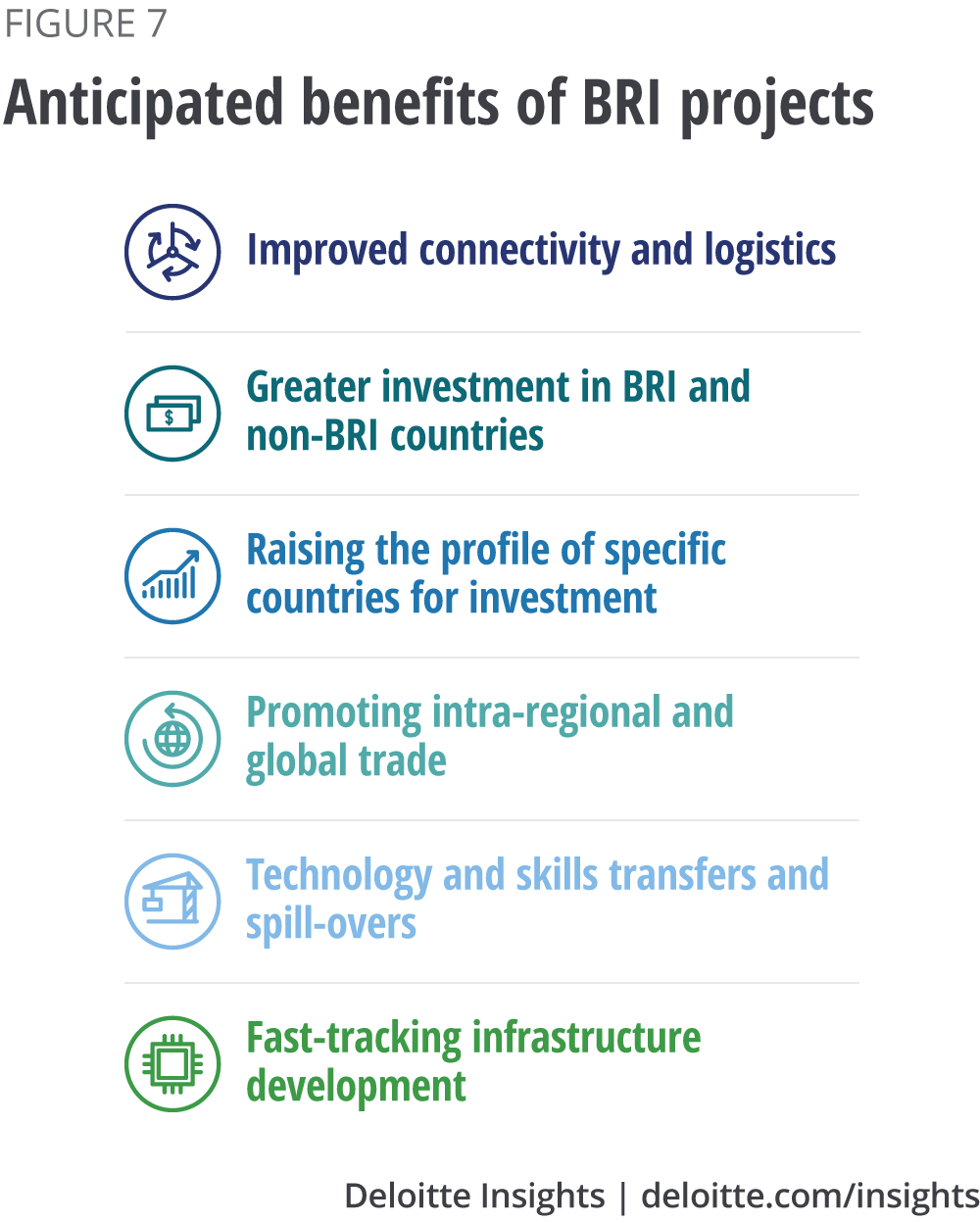
BRI projects and initiatives are an extension of the BRI goals and the African Union’s Agenda 2063 and Programme for Infrastructure Development in Africa (PIDA), which push for greater regional integration within the continent. The success of the BRI projects for Africa could depend on their ability to tap into the economic corridors of BRI economies. The inland, hinterland and naval connection could boost African countries’ logistical efficiency and export capacity, making the products of African countries available at lower shipping costs and higher turnover rates.
Improving connectivity and logistics is important for promoting African goods and commodity exports, which can thereby help African countries to integrate more fully into global value chains. According to the World Bank, a 1 per cent reduction in trade costs is likely to increase bilateral trade between economies that participate in the BRI projects by 1.3 per cent.29 The improvement in the network and capacity of railways and other cross-border transport infrastructure could therefore lead to more intra-African trade, as well as increased investment, the associated technology and skills transfers, and higher growth in African economies. Initial estimates suggest that the BRI transportation networks could boost FDI in Africa by 7.4 per cent, with the largest impact on GDP growth in the SSA region.30 Regional cooperation on infrastructure improvement is important and could be especially significant for landlocked countries.
As BRI projects are favoured in terms of accessing loans from China Exim Bank, these projects are likely to receive faster approval and realisation than other Chinese-funded infrastructure projects in Africa. Furthermore, BRI-led projects carry social currency, as industrial estates and economic cooperation zones have proven in Kenya and Ethiopia. These zones have been able to raise their profile under this initiative. With Chinese companies having set up more than 56 economic cooperation zones in more than 20 countries, generating US$1.1bn in tax revenues and 180,000 jobs over the 2014-16 period, these hubs for capital and manufacturing investments may trigger broader market reforms and spur local employment, export earnings and growth.31
Conclusions
There are concerns about China’s interests in Africa, with criticisms often ranging from China’s self-interest to the nature of the financing relationship and increasing indebtedness of African economies. But abundant Chinese funds at a time when African countries are looking for alternative sources of development finance, and the global appetite and capacity of Chinese construction firms, could be a win-win combination for China and Africa.
In addition, the Belt and Road Initiative, benefiting from Chinese firms’ access to preferential financing for overseas investments and exports, is making African economies more connected to one another and to the outside world, boosting economic diversification and growth. This is likely to strengthen China’s activity in Africa’s I&CP sector.
© 2021. See Terms of Use for more information.
Related articles
-
Volatility in emerging economies: Is contagion too harsh a word? Article6 years ago
-
Power & Utilities Collection
-
Government & Public Services Collection









